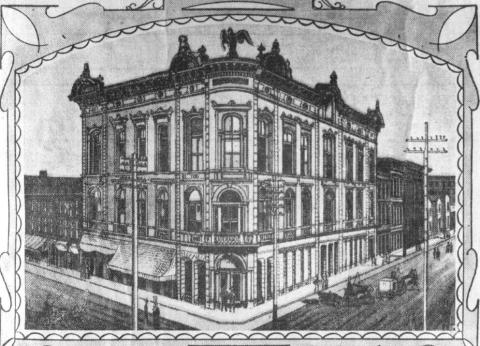“A Minstrel Town”, by Marion S. Revett, published by Pageant Press Inc. NY, in 1955. pp 87-97.
Wheeler Opera House, on the other hand, was a fabulous place (The Wheeler narrative is right after another hall called White’s). It became known all over the theatrical world for its modern arrangements, its magnificent decorations and its stage and lighting facilities. Jeff Wheeler, wealthy business man and sportsman, was proud of this monument to his family name.
On December 9, 1870, he granted a press interview and a tour of the new building. In the days of gas light, fire was the one hazard feared in all public places. Mr. Wheeler outlined the precautions.
On the roof of the building was an iron tank holding 350 barrels of water. By means of hose stretched in all directions throughout the Opera House, he was convinced that fire could be controlled at a moment’s notice. Just to make sure, he had also installed an outside fire escape, accessible from every floor of the theater.
Wheeler’s was located at the northwest corner of Monroe and St. Clair streets, with the main entrance on St. Clair, opening upon a great staircase thirteen feet wide. The staircase ascended to a broad vestibule on the second floor, in which were found the ticket offices and the clock rooms. These cubicles were then flanked by two shorter stairways, one on each side, leading up to the lobby of the theater, then leading down into the orchestra section. Doors swung in both directions for easy exit; upon entering the lofty auditorium the audience was impressed by the stage. Seventy-seven feet of clear width from wall to wall and forty-three feet deep. There were six traps and ten shifts of scenery. Four ranges of border lights illuminated the stage from above, and were carefully guarded by screens to make it impossible for any of the canvas to come into contact with the burners. To the right, facing the stage, was the prompter’s desk, to which was attached the key table, enabling the prompter to regulate the gas in any part of the house without interfering with other lighting apparatus. The stage entrance was on Monroe street offering additional emergency exits to patrons.
The drop curtain had, to right and left, massive folds of crimson and green damask, and when drawn aside, revealed in the center an immense figure of Poetry, the mother of all arts.
The pirouette, nearest the stage, was furnished with 300 tilting chairs upholstered in leather. The floor, inclining towards the stage, was adjusted upon an axis to allow its being made completely level, within five minutes, to form a dance floor. The dress circle, immediately behind the pirouette, seated another 300. The balcony, seating 360, was furnished with carved seats made of alternate slats of ash and black walnut. The third floor, or family circle, held another 360 seats, permitting a total of 1400 people in the building.
The frescoing in the arch above the stage displayed a portrait of Shakespeare, and to his right were life-size pictures of Beethoven and Goethe. To the left were pictures of Mozart and Schiller. The interior of the dome, arching over the mammoth crystal chandelier, was decorated with the figures of the nine Muses: Terpsichore, Lyric, Poetry, Comedy, Music, Oratory, Tragedy, Astronomy, Epic Poetry, and History.
The playhouse opened on December 15, 1871, with Parepa Rosa’s English Opera Company in Bohemian Girl and Martha. There was a four hour lineup at the box office, and by noon two-thirds of the tickets for both performances had been sold. http://medamana.org:7086/wheelerh/wheeler-opera-house.html
Twain and Cable were there December 15, 1884
Image: This was one of Carl Schon's designs. It was built in 1870-1871 and burned down in 1893. The place attracted a high class of performers, including Buffalo Bill Cody, Lillie Langtry, Edwin Booth, and Sarah Bernhardt. Notice the eagle on the roof. It was made of iron and had a nineteen foot wingspan. http://damerosehay.blogspot.com/2007/11/wheelers-opera-house-downtown-toledo.html
Clippings from Toledo Blade December 15 and 16, 1884
Courtesy:
Local History and Genealogy Department
Toledo-Lucas County Public Library
325 N. Michigan Street
Toledo, Ohio 43604
(419)259-5233
